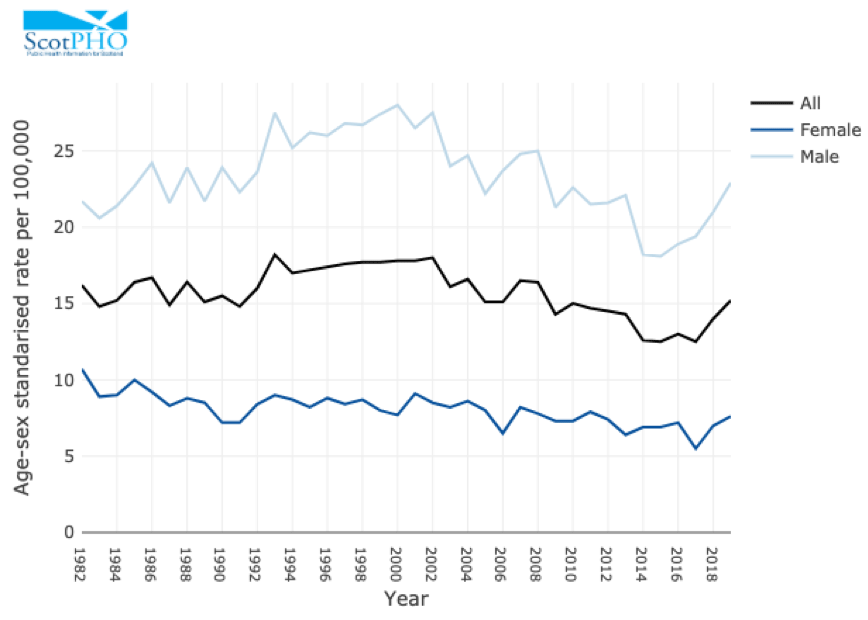Suicide prevention action plan 2018 - 2020: review
A review of progress made on Every Life Matters, Scotland’s Suicide Prevention Action Plan (SPAP) 2018 – 2021, over the period September 2018 to October 2020.
2. The Suicide Prevention Action Plan context
2.1 Recent trends in suicide in Scotland
Chart 1 shows the trend in age-sex standardised suicide rates per 100,000 (among females, males and persons) from 1981 to 2019. Among males, after a downward trend from 2000, the suicide rate has been on the rise over the past four years. The overall European age-standardised suicide rate (EASR) has risen from 18.5 per 100,000 population in 2015 to 23.3 per 100,000 in 2019. This is the highest rate since 2013. The peak incidence among men continues to be found in the 35-44 and 45-54 age groups (EASRs of 34.4/100,000 and 35.8/100,000, respectively). However, it is in the youngest and oldest adult groups that the most marked increases in male suicide rates can be seen. The 2019 rate among 15-24 year old men (24.0/100,000) is the highest since 2007 and the rate among 25-34 year olds is the highest since 2013. At the other end of the life course, the 2019 suicide rates among 65-74 and 75-84 year old men (17.3/100,000 and 18.3/100,000, respectively), while low compared to other age groups, are the highest since 2008. The result of these trends has been a narrowing of the differences in rates among different age groups.

The overall suicide rate among women was also on a downward trend from the early 2000s (9.1/100,000 in 2001) to 2017 (5.7/100,000). There has been an increase in the rate during 2018 and 2019 (7.6/100,000 in 2019). As for men, the highest rates among women are in the 35-45 (10.8/100,000) and 45-54 (14.0/100,000) age groups. The most notable, and concerning, change in female suicide rates, however, can be seen among young adults aged 15-24. In 2019 the rate in this age group was 10.7/100,000, the highest rate for at least 37 years. (Data on ScotPHO website start in 1982.) In 2015 there were 8 suicide deaths among women aged 15-24 years; in 2019 this number increased to 33.
2.2 Local suicide prevention activities in Scotland
In most local authority areas, suicide prevention is undertaken operationally by an identified resource, although time and funding allocated to this activity varies greatly between areas. Local suicide prevention leads have brought their experience and knowledge to bear in the various developmental stages of Actions that have been progressed to date, particularly Actions 2, 3 and 4, and are contributing to the ongoing work on Actions 1 and 10. In addition to mirroring the work that is taking place at national level, local areas have forged ahead in exploring ways of addressing locations of concern as well as developing improved inter-agency data sharing on suicide deaths. Some areas have also linked with other services, such as addiction services, to develop more integrated responses, particularly where the evidence suggests increased suicide risk.
2.3 Implications of COVID-19
2.3.1 Impact on implementation of the SPAP
The Scottish Government's Programme for Government notes that "[t]he impact of COVID-19 has been felt across Scotland. It has disrupted our everyday lives, our families, our communities and our economy. It has had a profound effect on our wellbeing as a nation" (Scottish Government, 2020b, page 17). It has also created major challenges to statutory and third sector organisations which are committed to delivering timely and appropriate support to an increasing number of people with mental health problems resulting from lockdown and other features of the governmental response to the pandemic.
Several actions in the SPAP had to be put on hold while delivery leads were required to support activity related to the immediate impact of the pandemic in other health and social care settings. Progress was especially impeded in relation to Actions 1, 4, 5 and 10. As noted in the NSPLG's Second Annual Report (NSPLG, 2020a, page 5): "The COVID-19 pandemic and the consequent need for delivery partners' efforts to be temporarily focused elsewhere has meant that some work has not progressed as far as all those involved would have wished."
2.3.2 NSPLG Statement: priorities during the pandemic
In June 2020, the NSPLG published a statement on the pandemic which identified four immediate priorities for action to mitigate the potential impacts of the pandemic on suicidal behaviour (table 2) (NSPLG, 2020b). The statement also made a strong recommendation to develop a long-term suicide prevention strategy, potentially covering a 10-year period following the completion of the SPAP (i.e., from September 2021). The four priorities were fully accepted by the Scottish Government and CoSLA. The 2020-21 Programme for Government included a commitment to developing a longer-term suicide prevention strategy in collaboration with CoSLA and other partners (Scottish Government, 2020b, page 83).
Table 2. NSPLG Priorities for pandemic-related suicide prevention action
Purpose
1 Closer national and local monitoring of enhanced and more timely suicide and self harm data
- To facilitate rapid response to changing trends, especially at local level.
- To facilitate prompt identification of new groups at risk of suicide and known groups at increased risk of suicide.
2 Specific public suicide prevention campaigns, distinct from and in partnership with the umbrella 'Clear Your Head' mental health and wellbeing campaign
- To encourage people at risk of suicide and in suicidal crisis to seek help without stigma and to encourage others to give it.
- To address the complexity of factors that lead to suicidal behaviour and create stigma.
3 Enhanced focus on specifically suicidal crisis intervention
- To ensure that those in suicidal crisis can access timely help and support, and meet any increase in persons seeking such support.
4 Restricting access to means of suicide
- To reduce the availability to those in crisis of the most commonly used means of suicide, in community as well as institutional settings.
Contact
There is a problem
Thanks for your feedback